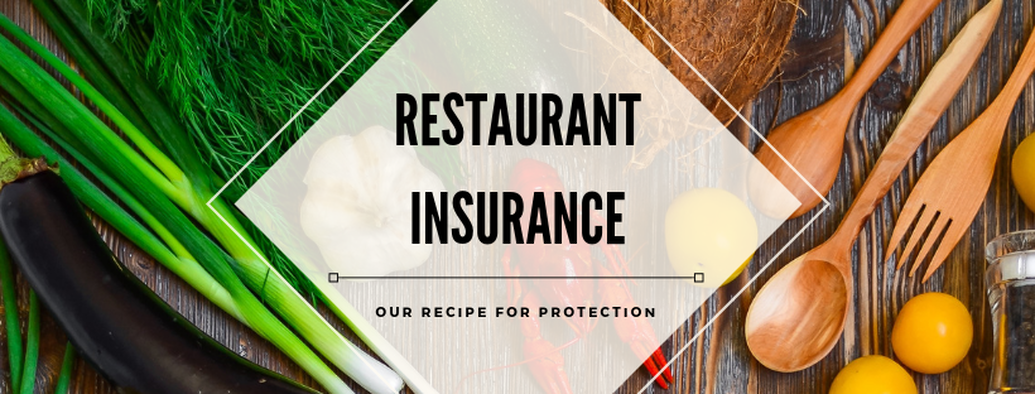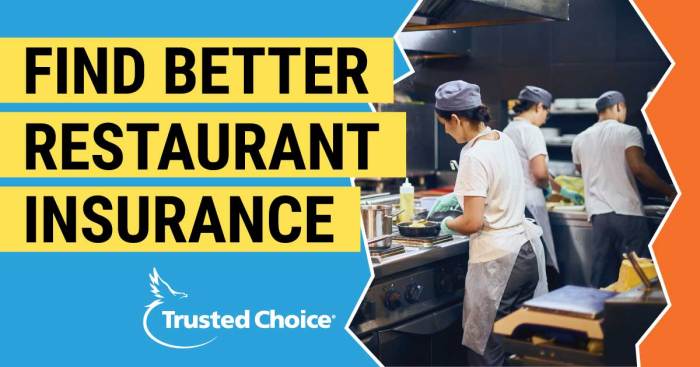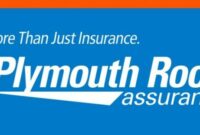Restaurant insurance is a crucial aspect of owning and operating a successful food service establishment. It provides a safety net against unforeseen events, offering financial protection for your business, your employees, and your customers.
From slip-and-falls to food poisoning, restaurants face a myriad of potential risks that can lead to costly lawsuits, property damage, and operational disruptions. Restaurant insurance policies are designed to mitigate these risks, ensuring your business can weather the storm and continue serving delicious meals.
What is Restaurant Insurance?

Restaurant insurance is a crucial safety net for restaurant owners, protecting them from various risks and financial burdens. It provides coverage for a range of potential incidents that can occur in a restaurant, ensuring business continuity and financial stability.
Types of Coverage
Restaurant insurance policies typically encompass various types of coverage, tailored to address the unique needs of the restaurant industry.
- Property Insurance: This coverage protects the restaurant’s physical assets, including the building, equipment, furniture, and inventory, against damage or loss due to fire, theft, vandalism, or natural disasters.
- Liability Insurance: This coverage safeguards the restaurant against claims of negligence or injury to customers, employees, or third parties. It covers legal expenses and settlements arising from accidents, slip-and-fall incidents, or food poisoning.
- Business Interruption Insurance: This coverage provides financial support to the restaurant if it is forced to close due to an insured event, such as a fire or natural disaster. It helps cover lost revenue and ongoing expenses during the downtime.
- Workers’ Compensation Insurance: This coverage is mandatory in most states and protects employees from injuries or illnesses sustained while on the job. It covers medical expenses, lost wages, and rehabilitation costs.
- Liquor Liability Insurance: For restaurants that serve alcohol, this coverage protects them from claims arising from intoxicated patrons, such as drunk driving accidents or assaults.
Why is Restaurant Insurance Necessary?
Running a restaurant is a complex and multifaceted endeavor, involving a wide range of risks that could potentially impact the financial well-being of the business. Accidents, lawsuits, and property damage are just some of the unforeseen events that can arise, leading to significant financial losses.
Restaurant insurance serves as a crucial safety net, providing financial protection against these risks and ensuring the long-term sustainability of the establishment.
Financial Protection Against Unforeseen Events
Restaurants face a unique set of risks that can lead to substantial financial losses. Accidents, such as slips and falls, food poisoning, or fires, can result in costly medical expenses, property damage, and legal liabilities. Additionally, lawsuits stemming from customer injuries, foodborne illnesses, or allegations of negligence can significantly impact the restaurant’s financial stability.
Restaurant insurance provides financial protection against these unforeseen events, covering medical expenses, property damage, and legal defense costs, helping businesses mitigate the financial burden associated with such incidents.
Key Reasons for Restaurant Insurance Coverage
- Liability Coverage:This protects the restaurant from financial losses arising from customer injuries, property damage, or other incidents caused by the restaurant’s negligence. For example, if a customer slips and falls on a wet floor, liability insurance would cover medical expenses, legal fees, and any damages awarded in a lawsuit.
- Property Coverage:This covers the restaurant’s physical assets, including the building, equipment, furniture, and inventory, against damage or loss due to fire, theft, vandalism, or natural disasters. This ensures that the restaurant can rebuild or replace damaged assets and continue operations.
- Business Interruption Coverage:This provides financial support to cover lost income and ongoing expenses during periods when the restaurant is forced to close due to an insured event. This helps to maintain the business’s financial stability and ensures its ability to resume operations.
- Workers’ Compensation Coverage:This protects employees in case of work-related injuries or illnesses. It covers medical expenses, lost wages, and rehabilitation costs, ensuring that employees receive necessary care and support.
- Liquor Liability Coverage:For restaurants serving alcohol, this insurance covers the business against claims related to alcohol-related incidents, such as drunk driving accidents or injuries caused by intoxicated patrons.
Legal Requirements for Restaurant Insurance
Restaurant insurance is not just a good idea; it is often a legal requirement in many jurisdictions. The specific insurance requirements vary by region, but generally include:
- General Liability Insurance:This is usually a mandatory requirement, covering the restaurant’s liability for accidents or injuries occurring on the premises.
- Workers’ Compensation Insurance:This is typically required for businesses with employees, protecting them against work-related injuries or illnesses.
- Liquor Liability Insurance:This is required for restaurants serving alcohol, covering the business against alcohol-related incidents.
It is essential for restaurant owners to consult with insurance brokers or agents to understand the specific insurance requirements in their region and to obtain appropriate coverage to protect their business.
Types of Restaurant Insurance Coverage
Restaurant insurance is designed to protect your business from various risks, ensuring you can continue operating smoothly even in the face of unforeseen circumstances. It’s crucial to understand the different types of coverage available to determine the best fit for your restaurant’s specific needs.
Types of Restaurant Insurance Coverage
Understanding the various types of coverage offered is essential for making informed decisions about your restaurant’s insurance needs. Here’s a table summarizing different types of restaurant insurance:
| Coverage Type | Description | Examples |
|---|---|---|
| General Liability Insurance | Protects your business from claims arising from bodily injury or property damage to third parties. This covers accidents that occur on your premises, including slips and falls, or damage caused by your employees. | A customer slips on a wet floor and suffers a broken leg. A delivery driver accidentally bumps into a parked car while making a delivery. |
| Property Insurance | Covers damage to your restaurant building, equipment, inventory, and other physical assets. This protects you against losses due to fire, theft, vandalism, or natural disasters. | A fire damages your kitchen equipment. A storm causes significant damage to your restaurant’s roof. |
| Business Interruption Insurance | Provides financial protection if your restaurant is forced to close due to a covered event, such as a fire or natural disaster. This covers lost income and ongoing expenses while your business is unable to operate. | Your restaurant is closed for several weeks due to a fire. You lose income from lost sales and still have to pay rent and utilities. |
| Workers’ Compensation Insurance | Covers medical expenses, lost wages, and other benefits for employees who are injured or become ill on the job. This is mandatory in most states. | A waiter slips and falls while carrying a tray of food, injuring his back. A cook develops a respiratory illness due to exposure to fumes in the kitchen. |
| Liquor Liability Insurance | Protects your business from claims related to the sale or service of alcoholic beverages. This covers injuries or damages caused by intoxicated patrons. | A customer becomes intoxicated and causes a fight, injuring another patron. A drunk driver causes an accident after leaving your restaurant. |
| Product Liability Insurance | Covers claims arising from injuries or illnesses caused by food or beverages served at your restaurant. This protects you against lawsuits related to food poisoning or allergic reactions. | A customer suffers food poisoning after eating a meal at your restaurant. A customer with a nut allergy has a severe reaction after consuming a dish containing nuts. |
| Crime Insurance | Provides protection against losses due to theft, robbery, or employee dishonesty. This covers stolen cash, inventory, or other valuable assets. | Your restaurant is robbed and cash is stolen from the register. An employee embezzles funds from your business. |
| Cyber Liability Insurance | Protects your business from financial losses and legal expenses resulting from cyberattacks, data breaches, or other cybersecurity incidents. This covers costs related to data recovery, legal defense, and regulatory fines. | Your restaurant’s computer system is hacked, leading to the theft of customer data. A ransomware attack disrupts your operations and demands a ransom payment. |
Factors Influencing Restaurant Insurance Costs
Restaurant insurance premiums are influenced by a range of factors, including the restaurant’s size, location, menu type, and risk profile. Understanding these factors can help restaurant owners make informed decisions about their insurance needs and potentially lower their premiums.
Restaurant Size
The size of a restaurant significantly impacts its insurance costs. Larger restaurants typically have higher premiums due to increased potential for accidents, injuries, and property damage. This is because they usually have more employees, serve a greater number of customers, and handle larger quantities of food and beverages.
For example, a large, bustling restaurant with a busy kitchen and a large dining area will likely have higher insurance premiums than a small, cozy cafe.
Restaurant Location
The location of a restaurant is another key factor influencing insurance costs. Restaurants in high-crime areas or areas with a high density of pedestrians may have higher premiums due to an increased risk of theft, vandalism, and liability claims. Additionally, restaurants in areas with a high concentration of other restaurants may face higher competition, which could lead to increased risk of foodborne illnesses and customer complaints.
Menu Type
The type of food served by a restaurant can also affect its insurance premiums. Restaurants serving high-risk foods, such as raw seafood or dishes requiring extensive preparation, may face higher premiums due to an increased risk of foodborne illnesses. For example, a sushi restaurant specializing in raw fish may have higher premiums than a restaurant serving pre-cooked dishes like pizza or burgers.
Restaurant Risk Profile
The overall risk profile of a restaurant is a critical factor in determining insurance costs. This profile considers various aspects, including the restaurant’s safety record, employee training, and compliance with food safety regulations. Restaurants with a history of accidents, injuries, or food safety violations may face higher premiums due to their increased risk.
Finding the Right Restaurant Insurance Policy
Navigating the world of restaurant insurance can feel overwhelming, but finding the right policy doesn’t have to be a daunting task. By following a strategic approach, you can secure the coverage you need at a price that works for your business.
Steps to Finding the Right Policy
A well-defined plan helps you find the right insurance policy. Follow these steps:
- Assess Your Needs: Begin by understanding your restaurant’s unique risks. Consider factors like the type of cuisine you serve, your location, the size of your operation, and any specific equipment or activities. This assessment helps you identify the essential insurance coverages you need.
- Gather Quotes from Multiple Providers: Don’t settle for the first quote you receive. Contact several reputable insurance companies or brokers to get a range of options. Be sure to compare not only the premium but also the coverage details, policy terms, and the insurer’s financial stability.
- Review and Compare Quotes: Carefully analyze each quote, paying attention to the following:
- Deductibles: The amount you pay out-of-pocket before your insurance kicks in. Higher deductibles generally mean lower premiums, but you’ll need to consider your risk tolerance.
- Limits: The maximum amount your insurer will pay for a covered claim. Ensure the limits are sufficient to cover your potential losses.
- Exclusions: Specific events or circumstances not covered by the policy. Carefully review exclusions to avoid surprises later.
- Seek Expert Guidance: Working with a knowledgeable insurance broker or agent can simplify the process. They can help you understand complex policy terms, identify the right coverages for your needs, and negotiate favorable rates.
Tips for Comparing Quotes
When comparing quotes, consider these key factors:
- Coverage: Ensure all quotes cover the same types of risks and include the same essential coverages. This allows for a fair comparison.
- Premiums: Compare premiums from different insurers, keeping in mind the coverage levels and policy terms. Don’t solely focus on the lowest premium; prioritize comprehensive coverage.
- Claims Process: Inquire about the insurer’s claims process, including how long it typically takes to process claims and the level of customer service they provide.
- Financial Stability: Research the insurer’s financial strength and rating. This indicates their ability to pay claims in the future. A strong financial rating provides greater peace of mind.
Understanding Policy Terms
Take the time to thoroughly understand the terms of your insurance policy. Common terms include:
- Policy Period: The duration of your insurance coverage, typically a year. Renewals are common.
- Cancellation Clause: Specifies the conditions under which you or the insurer can terminate the policy. It’s crucial to understand the potential implications of cancellation.
- Subrogation: The insurer’s right to pursue compensation from a third party responsible for a covered loss. This helps reduce your out-of-pocket expenses.
Importance of a Reputable Broker or Agent
Working with a reputable insurance broker or agent offers several advantages:
- Expertise: Brokers and agents have specialized knowledge of the insurance industry and can guide you towards the right policy for your specific needs.
- Negotiation Skills: They can leverage their relationships with insurers to negotiate favorable rates and policy terms on your behalf.
- Claims Assistance: They can assist you with filing claims and navigating the process, ensuring a smoother and more efficient experience.
Common Restaurant Insurance Claims
Restaurant insurance is designed to protect your business from a wide range of risks, and claims can arise from various unforeseen events. Understanding common claims can help you better understand the coverage you need and the importance of having adequate insurance.
Types of Claims
Restaurants often file claims for incidents related to:
- Property Damage:This covers damage to your restaurant building, equipment, and inventory due to fires, floods, storms, vandalism, or theft. For example, a fire caused by a malfunctioning appliance or a break-in resulting in stolen equipment would fall under this category.
- Liability:This protects you from lawsuits arising from injuries or property damage caused to customers or third parties on your premises. For example, a customer slipping on a wet floor and sustaining injuries, or a delivery driver damaging a car while making a delivery, would be covered under liability insurance.
- Foodborne Illness:This coverage protects you from claims related to food poisoning caused by contaminated food served at your restaurant. This is a critical aspect of restaurant insurance, as foodborne illness outbreaks can result in significant legal expenses, lost revenue, and reputational damage.
- Employee Injury:Workers’ compensation insurance is mandatory in most states and covers medical expenses and lost wages for employees injured on the job. This includes injuries sustained while performing work duties, such as a chef cutting their hand while preparing food.
Examples of Incidents
Here are some real-world examples of incidents that might trigger insurance claims:
- Fire:A faulty electrical wiring in the kitchen starts a fire, causing extensive damage to the restaurant’s interior and equipment.
- Slip and Fall:A customer slips on a spilled beverage on the floor, resulting in a broken leg and medical expenses.
- Foodborne Illness:A customer contracts salmonella poisoning after eating contaminated food, leading to medical bills and potential legal action.
- Theft:An employee steals cash from the register, causing a financial loss for the restaurant.
- Employee Injury:A waiter accidentally drops a heavy tray on his foot, leading to a sprained ankle and time off work.
Filing a Claim, Restaurant insurance
When an incident occurs that may warrant an insurance claim, it’s crucial to take the following steps:
- Report the incident to your insurance company immediately.This allows them to start investigating the claim and initiate the process.
- Gather all relevant documentation,such as police reports, medical records, and invoices for repairs or replacements.
- Cooperate fully with the insurance company’s investigation.This includes providing requested information and attending any necessary meetings.
- Keep detailed records of all expenses related to the incident.This will help you support your claim and ensure you are compensated for all losses.
Restaurant Insurance Best Practices

Restaurant insurance is essential for protecting your business from financial losses due to unexpected events. While having a comprehensive insurance policy is a crucial step, implementing best practices can further minimize your risk and enhance your overall security.
Preventing Accidents and Reducing Claims
Proactive measures are key to preventing accidents and minimizing the likelihood of claims. By implementing a strong safety culture and adhering to industry standards, you can significantly reduce your risk exposure.
- Regularly Inspect and Maintain Equipment: Regular inspections and maintenance of kitchen equipment, appliances, and other facilities can help prevent malfunctions, fires, and other accidents.
- Train Staff on Safety Procedures: Thoroughly train staff on proper safety procedures, including fire safety, food handling, and first aid. This ensures they are prepared to handle emergencies and minimize risks.
- Implement a Slip and Fall Prevention Program: Slips and falls are common in restaurants. Implement a program that includes regular floor cleaning, proper signage, and non-slip mats to reduce the risk of accidents.
- Maintain a Clean and Organized Kitchen: A clean and organized kitchen is essential for food safety and reduces the risk of accidents. Implement a thorough cleaning schedule and ensure all surfaces are kept sanitized.
- Implement a Food Safety Program: Adhering to food safety regulations is crucial for preventing foodborne illnesses and protecting your customers. Implement a robust food safety program that includes regular training, temperature monitoring, and proper food handling procedures.
Maintaining Accurate Records and Documentation
Accurate records and documentation are crucial for supporting insurance claims and demonstrating compliance with regulations.
- Keep Detailed Records of Accidents and Incidents: Document all accidents and incidents, including date, time, location, witnesses, and any injuries or damages. This documentation will be invaluable in the event of an insurance claim.
- Maintain Comprehensive Inventory Records: Keep detailed records of your restaurant’s inventory, including equipment, supplies, and food products. This documentation will help you assess losses in the event of a fire, theft, or other disaster.
- Store Important Documents in a Safe Location: Store important documents, such as insurance policies, contracts, and financial records, in a safe and secure location. This ensures their availability in case of an emergency.
Closing Notes
Navigating the world of restaurant insurance can seem daunting, but understanding the different types of coverage, the factors influencing costs, and the best practices for risk management can help you secure the right policy for your specific needs. By investing in comprehensive restaurant insurance, you can protect your investment, ensure peace of mind, and focus on what you do best: creating unforgettable dining experiences.
Questions Often Asked
How much does restaurant insurance cost?
Restaurant insurance premiums vary depending on factors like restaurant size, location, menu type, and risk profile. It’s best to obtain quotes from multiple insurance providers to compare prices and coverage options.
What is the difference between general liability insurance and product liability insurance?
General liability insurance covers bodily injury or property damage caused by your business operations, while product liability insurance specifically covers injuries or damages resulting from consuming your food or beverages.
Do I need workers’ compensation insurance?
In most states, employers are required to carry workers’ compensation insurance to cover medical expenses and lost wages for employees injured on the job.
What are some tips for preventing accidents and reducing the likelihood of claims?
Implementing safety protocols, training employees on proper procedures, maintaining a clean and organized work environment, and regularly inspecting equipment can help minimize accidents and reduce the risk of claims.




